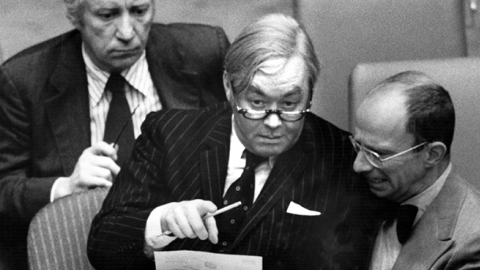p(firstLetter). The Moral Dimensions of a Two Trillion Dollar Debt” is the title of an address delivered a third of a century ago, by Senator Daniel Patrick Moynihan, on January 27, 1986, at St. Paul’s Episcopal Church in Rochester, New York. Pat began with the theological ambivalence toward the activity of lending, investment, and accumulation that we now call capitalism.1 The Hebrew Bible’s injunction pointed one way—Thou shalt not give [thy brother] thy money upon interest, not give him thy victuals upon increase. The New Testament’s parable of the talents pointed another—”the good servant puts his capital to work and it increases.” The Catholic Church, he observed, no doubt with a twinkle in his eye, had tended to view capitalism as a “Protestant heresy.” On this point, Pat sided with the heretics assembled before him: Christianity teaches the virtue of self-denial and “warns against the terrible cost of discounting future rewards in favor of present ones.”
The same was true of public borrowing—up to a point. The City of Rochester blossomed in the 1820s on heavy borrowing by New York State to finance the digging of the Erie Canal. In 1986, the city continued to thrive on public and private credit for “projects of indisputable virtue and reasonable prospects” (and he let it slip that some of those loans were provided by federal agencies through the good offices of Senator Moynihan). Nevertheless, Pat said,
… there can be no doubt that public debt is much more problematic. This arises from the obvious fact that the people who do the borrowing, which is to say elected officials, are not the ones who will do the repaying. The temptation is real to use debt not as a form of investment, but a means of consumption. Far from the denial of gratification, it can, and frequently does, reflect just the opposite.
Whereupon he delivered a nutshell history of American public finance—in his telling, centuries of resisting temptation followed by five years of dissolute debauchery. The federal government had run deficits many times in the nineteenth century, but only during wars and recessions—and “the debts were paid off with great promptness once there was a change in the particular circumstances that had given rise to them.” During the Great Depression, Keynesian economics had had “little if any influence on the New Deal.” But it did introduce a new way of thinking about deficits—not just as an unfortunate side-effect of economic hard-times and falling tax revenues, but as a deliberate policy to sustain incomes and demand until the economy recovered. This led eventually to a variety of innovations such as, during the Nixon Administration in the early 1970s, the “Full Employment Budget”—with deficits equal to the tax revenues that would have come in from the currently unemployed if they had had paying jobs. Pat called this counterfactual budget balancing “a euphemism of sorts.”
And then, with the arrival of Ronald Reagan in 1981, came dissolution. Supply-siders claimed that cutting tax rates would generate so much economic growth that tax revenues would hold steady or even increase at the lower rates. Libertarian spending-cutters doubted that would happen—but they thought the ensuing deficits might accomplish what they had failed to do directly. Friedrich Hayek had summarized the starve-the-beast strategy following a recent visit to the West Wing: “[I]t is impossible to persuade Congress that expenditures must be reduced, unless one creates deficits so large that absolutely everyone becomes convinced that no more money can be spent.”
But both Reagan camps had been wrong. Deficits had ballooned following the 1981 tax cuts, without inducing the least sense of spending restraint in Congress. The national debt had doubled from $1 trillion to $2 trillion by the time Pat spoke in 1986. “This,” he said, “has the makings of a crisis of the regime. I don’t think it will come to that; but it might.” Without a reversal of the 1981 tax cuts, either the currency would need to be debauched through inflation, or else critical defense and domestic programs would need to be cut “in a wholly indiscriminate and destructive manner.”
Read the full article in the American Interest "here":https://www.the-american-interest.com/2019/04/23/welfare-and-debt-a-moy…












